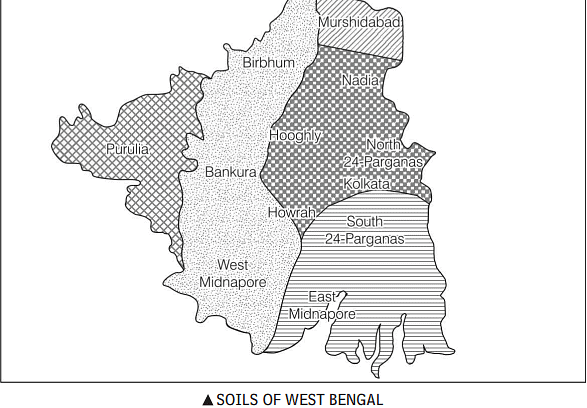WBCS (West Bengal) Exam > WBCS (West Bengal) Notes > WBCS Preparation: All Subjects > Soils of West Bengal
Soils of West Bengal | WBCS Preparation: All Subjects - WBCS (West Bengal) PDF Download
The diverse geographical and climatic conditions in West Bengal have led to the development of various soil types. The Department of Agriculture has classified these soils into six groups based on soil profile analysis.
- Mountain and Forest Soil
- Old Alluvium
- New Alluvium
- Red Soil
- Laterite Soil
- Saline Soil

 Mountain and Forest Soil
Mountain and Forest Soil
In the northern region of West Bengal, mountain soil is prevalent, formed through the weathering of igneous and metamorphic rocks. This soil, black in color and less fertile, is suitable for cultivating tea, pineapple, oranges, and pears. At an elevation of 2550 m in Darjeeling and Kalimpong districts, the mountain soil is found, while the regions below the mountains, known as 'the duars,' contain thick forests with forest soil. The latter has acidic humus and low base exchange capacity, sometimes sandy and gravelly, and is present in Alipurduar, Jalpaiguri, and Coochbehar districts, also referred to as Terai soil.
Old Alluvium
This comparatively older soil, known as Bhangar, is distributed north of the Ganga, encompassing North and South Dinajpur, Malda, Eastern Birbhum, and parts of Murshidabad, Bankura, and Birbhum. The Barind area consists of quasi lateritic alluvium, suitable for paddy, wheat, and sugarcane cultivation. This clayey soil is acidic, rich in potash and phosphorus, and contains moderate amounts of nitrogen and humus.
New Alluvium
This newer soil, known as Khadar, is found along riverbanks and is present in the plains of West Bengal south of the Bhagirathi river up to the mouth of the Hooghly river. Murshidabad, Nadia, Howrah, and North 24-Parganas have new alluvium soil, ideal for paddy, wheat, and jute cultivation. It is fertile with high humus content, water holding capacity, and low acidity due to organic material deposition during floods.
Red Soil
Found in districts like Birbhum, Bardhaman, Bankura, Midnapore, and parts of Malda and Dinajpur, red soil is characterized by its red, reddish-brown, or red-black color due to ferrous oxide presence. It has low water holding capacity, is poor in nitrogen and phosphate, high in potash and lime, and mildly acidic. Agriculture in this soil requires irrigation, and paddy is the main crop grown.
Laterite Soil
Present in the western plateau region and districts like Birbhum, Bardhaman, Bankura, Purulia, and Midnapore, laterite soil is red in color and generally infertile. Despite its infertility, limited vegetation can occur with proper irrigation. It is acidic, lacks organic matter, calcium, phosphates, and nitrogen, making it susceptible to soil erosion and leaching.
Clayey Saline Soil
The Sundarbans and coastal areas in the state have this bluish-colored soil, which is acidic and has loose particles due to excess organic matter. Unsuitable for cereal crops due to the lack of essential nutrients, it is well-suited for plantation crops like coconut, betel nut, and watermelon. This soil remains wet and saline for most of the year and is found in the southern part of South 24 Parganas and Midnapore.
The document Soils of West Bengal | WBCS Preparation: All Subjects - WBCS (West Bengal) is a part of the WBCS (West Bengal) Course WBCS Preparation: All Subjects.
All you need of WBCS (West Bengal) at this link: WBCS (West Bengal)
|
77 videos|109 docs
|

|
Explore Courses for WBCS (West Bengal) exam
|

|
Signup for Free!
Signup to see your scores go up within 7 days! Learn & Practice with 1000+ FREE Notes, Videos & Tests.
Related Searches

 Mountain and Forest Soil
Mountain and Forest Soil















